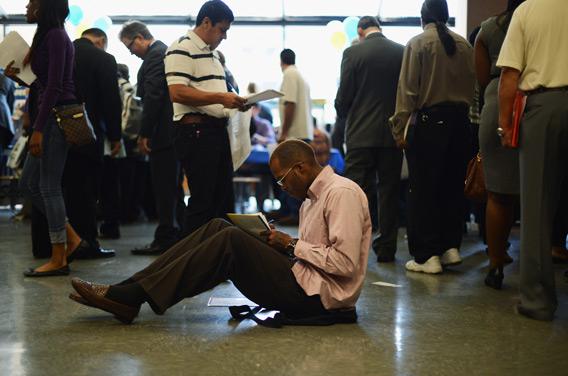This morning’s Employment Situation Report from the Bureau of Labor Statistics was bad news masking even worse news. The economy added 69,000 jobs in May, far below the consensus expectation of economic forecasters. And the consensus expectation wasn’t even particularly optimistic. Few thought we could repeat the 200,000-plus jobs per month that we were adding in the winter, and absolutely nobody dared hope for the kind of 300,000-400,000 monthly job increases that would be associated with a traditional bounce-back economic recovery. But 140,000 or 150,000 new jobs would at least have continued to take a bite out of unemployment. Instead we got 69,000—basically flat with population growth.
Except it’s even worse. With each new monthly data release, the BLS revises the previous two months’ data, and these revisions were devastating.
April’s employment growth was revised down from a decent 115,000 jobs to an anemic 77,000, and March’s healthy 154,000 got cut down to 143,000. Over the winter when job growth was strong and optimism was running high, old data were regularly revised upward—typically a sign of an economy with some strong growth patches that are being missed in simple surveys. Downward revisions are bad news, typically meaning that new firms are being formed at an abnormally slow level. There’s simply no good news anywhere in this report.
The tragedy is that this could—and should—have been avoided.
To understand why persistently high unemployment is avoidable, consider the “breakeven spread” between regular 10-year treasury bonds and inflation-protected treasury bonds. Since these instruments have the same maturity and the exact same government backing them, the gap between the interest rates is an indicator of market expectations of inflation over a 10-year horizon.* Ever since mid-March they’ve been slumping, probably because of bad news from Europe and the developing world. In particular, the eurozone crisis has increased demand for dollars while signs of a slump in China and India are reducing expectations for commodity prices.
Now normally you might think of reduced inflation expectations as a good thing. But one of the signature features of the Great Recession is that throughout the duration stock prices and inflation expectations have been closely correlated.
This is by no means the pattern you normally see through history, but it illustrates the unique properties of an economy in a severe slump. Since the Federal Reserve has already cut nominal interest rates to zero, the only way to further reduce borrowing costs is more inflation. The more inflation you’re expecting, the cheaper today’s low rates look and the more likely you are to invest in a house, a car, or an expansion of your business.
When things started to look shaky, Fed Chairman Ben Bernanke and his colleagues could and should have announced their firm determination to do whatever it takes to prevent inflation expectations from slumping and real rates from rising. That should have kept construction and other key sectors on track. Instead they mumbled that if the real economy collapsed in the future, they might do another round of quantitative easing.
But it’s not too late for them to turn around. Nobody likes to admit that they made a mistake (I kind of wish I hadn’t written this), but doing so would be much better than doubling down on an error. Bernanke needs to say that a modest and sustained increase in medium-team inflation would be healthy for the economy. If he doesn’t like how that sounds, he has many options. He could adopt Chicago Federal Reserve President Charles Evans’ proposed conditional inflation targeting language, my nominal income language, or the idea (with fans on the right and the left) of a monetary “regime change” refocused on nominal gross domestic product rather than prices.
It’s harder for the paralyzed U.S. Congress to take action, but there are helpful things they could be doing too. Resolving the upcoming “fiscal cliff” of automatic spending cuts and tax hikes would be nice. Agreeing not to put the country through another debt-ceiling panic would be even better. Taking advantage of the extraordinarily cheap rate at which the federal government can borrow money to cut checks to state governments might be best of all. Rather than furiously debating what would do the best job of boosting economic growth, more conservative states could use the money to cut taxes while more liberal ones could use the money to rehire some of the droves of public sector workers who’ve been laid off over the past two years.
Most likely, either would be helpful. Realistically, though, we may be too close to Election Day for the political branches to do anything. Both sides seem to have agreed that President Obama will take credit for job growth and blame for economic failure, meaning there’s no way the Republicans who control half the government will do anything constructive.
Correction, June 4, 2012: This article originally confused bonds of equal maturity with bonds of equal duration. (Return to the corrected sentence.)
